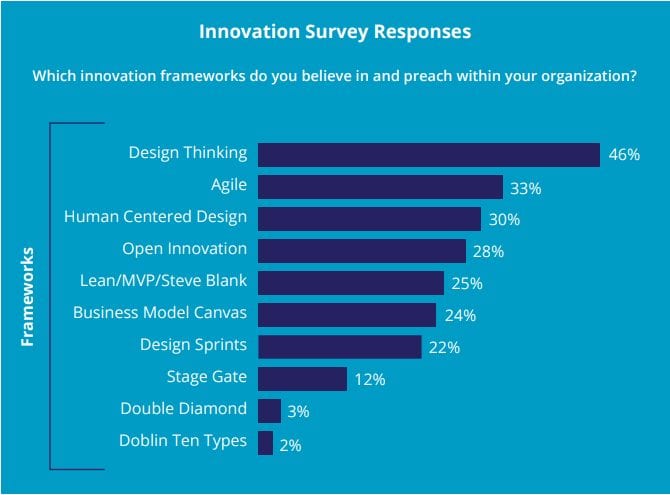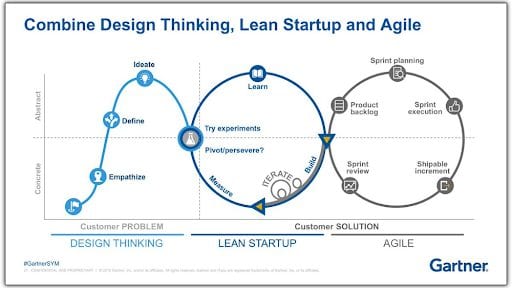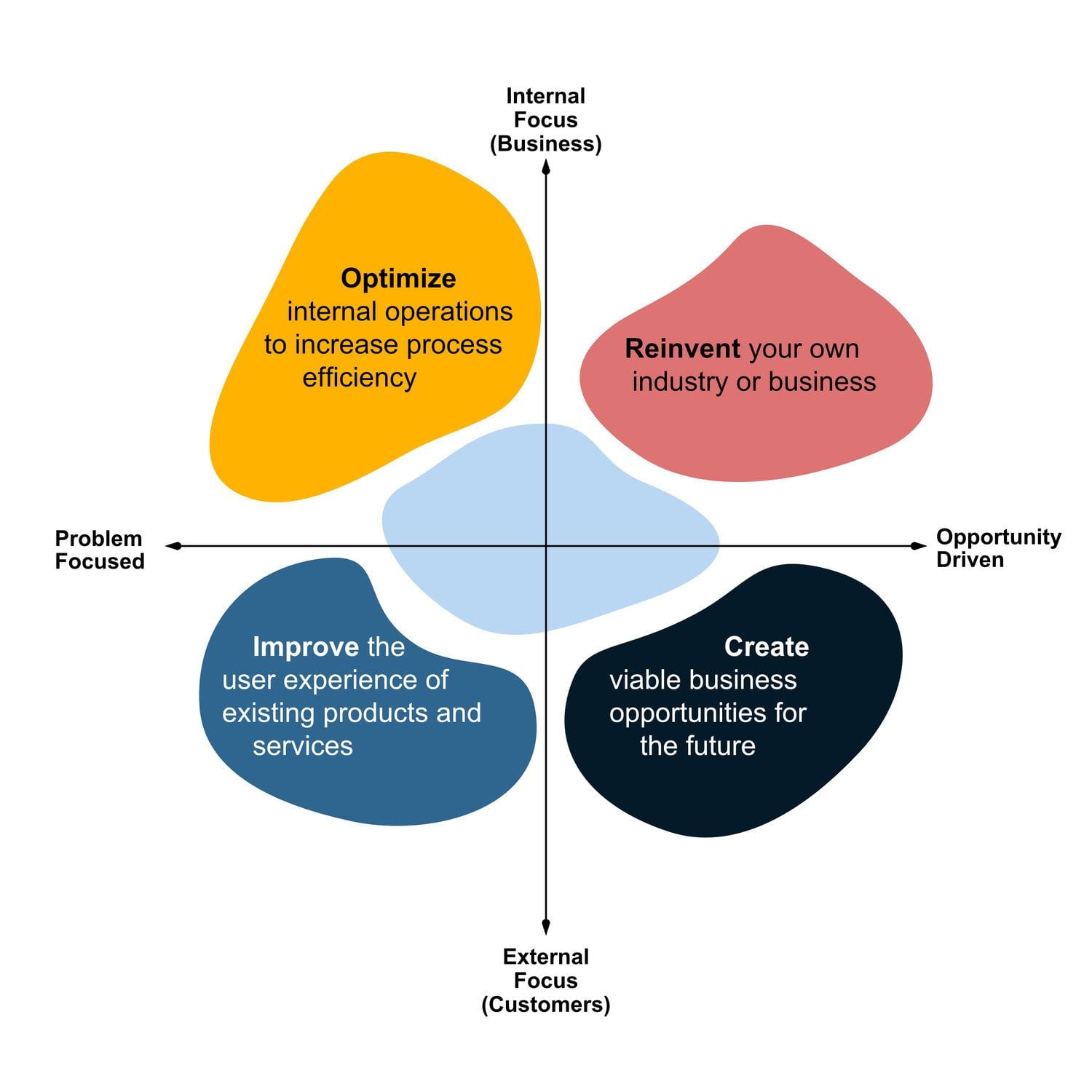Our website is not supported on this browser
The browser you are using (Internet Explorer) cannot display our content.
Please come back on a more recent browser to have the best experience possible

Innovation is everywhere. It’s the invention of new products, services, and approaches, whether just incremental, tangential, or truly disruptive. But it’s a process. It doesn’t just stop at the thinking of new things. It requires doing new things and then re-doing them. And that frankly is the hardest part. Many people don’t have a framework in place to deliver on innovation.
Innovation Frameworks are all about taking ideas, turning them into executable projects, and getting them out to market faster. In today’s fast-paced environment, organizations need to rapidly adapt to constant changes in both the business and technology environment. However, many clients struggle with shifting from traditional ways of doing things and how to innovate their products and businesses.
Dermot Brannock, MIGSO-PCUBED US General Manager, points out that although there are a lot of “great ideas out there,” if they can’t be commercialized, “they’re not much good to anyone.” Companies are showing that they have a new and growing appetite for innovation, he says. That capacity for taking ideas and creating something that generates revenue makes the back end of innovation, where execution must deliver on the promise, all the more important.
This appetite has led to a surge in innovation frameworks usage in the last few years. Bret Waters, CEO of innovation consulting firm 4thly, highlighted the rise of Innovation Frameworks like Design Thinking, Agile, Business Model Canvas, and Lean Startup in his 2019 Innovation Trends Report. 46% of organizations cite usage of Design Thinking principles, garnering the top spot.

Design Thinking, Lean Startup, and Agile are becoming so mainstream that in 2016, Gartner combined them together. You do need a membership to access the report, however, the image is extremely popular so you will find it referenced significantly across the net.

Read more on how we accelerated innovation in just 12 weeks for a leading Automotive OEM.
Figuring out your innovative solutions can be a daunting process as there are countless avenues to go down. However, at the end of one of those avenues is your competitive edge.
Dr. Sebastian Vetter with Innovate Strategy has a wonderful framework for identifying future innovation efforts. Whether you are trying to Improve, Create, Reinvent, or Optimize the overall business, your efforts will either have an internal or external focus.

“Organisations with an internal focus typically aim at increasing efficiency by optimizing processes and internal operations,” said Dr. Vetter. “While organizations with an external innovation focus aim at improving either the customer experience, or they try to create new products/services that increase revenue.”
Once you know whether your true customer is internal or external, then you can identify creative solutions to address real needs.
Read more on how we helped Sellafield create a more efficient, productive, and cost-effective organization through lean project delivery.
MIGSO-PCUBED has been helping more established companies to execute on innovation for over 25 years. We’ve aligned our approach to best practices in Design Thinking, Lean Startup, and the Scaled Agile Framework (SAFe).
Our approach leads clients through the three main phases of effective innovation management:
Design Thinking is a human-centered approach to innovation. Originating from Stanford’s d.School, it has since exploded in popularity as it seeks to dissect problems beyond the obvious by challenging perspectives that don’t align with user experiences.
Solutions are identified and vetted against one or multiple subjects, generally referred to as personas. These personas are fictional archetypal users whose goals and characteristics represent the needs of the end-user or client.

The five stages of Design Thinking are Empathize, Define, Ideate, Prototype, and Test. In workshops, you would come up with solutions to:
Read more on how to integrate the design thinking framework into your projects.
After you’ve defined the problem using human-centered design, it’s time to set up an environment for experimentation. This step is where you validate learning and develop your minimum viable product (MVP) quickly and with minimal resources (i.e. lean).
Lean Startup brings the entrepreneurial methods from startup organizations to larger more traditional organizations helping them bring their products to market quicker and cheaper than traditional methods.
There are three stages to lean startup:
These three steps can be repeated through iterations as much as necessary. However, you need to keep your maximum time and budget in mind to be efficient. This fact holds true for large corporations and small startups alike.
Lean Startup methodologies can apply to more than just private ventures. We recently used best practices from Lean Startup to help an important government client enable and encourage innovation across their organization.
The final rising methodology we are going to cover off is the Scaled Agile Framework (SAFe) currently on its 5.0 release. With an innovative product, service, or process passing the early selection phases, its time to deliver on those early promises made to customers. Its go time.
The Scaled Agile Framework (SAFe) by Scaled Agile has become the leading framework for enterprise agility. One main challenge is that as Agile has proliferated in use amongst teams, it is hard to scale up to the organizational or portfolio level.
As a Bronze level partner, we help many clients through Scaled Agile consulting, connecting their Delivery Agility to their Organizational Agility. In a recent engagement within Financial Services, our client needed help in standardizing and optimizing Agile best practices. The client needed help in visualizing all concurrent development in one portfolio tool. We worked with them to scale agile practices up to the portfolio level with JIRA Portfolio and Scaled Agile training and coaching.
The real challenge of innovation comes from choosing the ideas to turn into projects. All the creative problem-solving in the world doesn’t mean anything if there isn’t any follow-through.
Here are 6 questions to ask yourself when embarking on your innovation program:
Managed innovation also means managed change, and continuous change can be unsettling in an organization. How prepared is the company for that kind of environment?
Does the organization have the ability to understand customer needs and feed those insights back into the Innovation Teams?
Can management visualize what will be needed to implement an innovation fully and work with the company restructuring that may be required?
Does the company have the right people to translate concepts into prototypes or execute on new ideas?
Does the company culture enable project participants to adapt or change the direction of those projects as newer, better ideas surface?
Does the company recognize that good and great ideas come from all directions and that those ideas with true value need to be captured, acknowledged, and rewarded?
That said, properly executing on innovation takes an open mind to accept disruptive ideas and the patience to hear them out. When considering how innovation frameworks can help your own activities, here are 4 key insights to consider:
It’s not just for Google. Many companies give employees designated time and permission to explore new ideas. One company set 3D printers on the desks of its employees while other companies set aside time each day for employees to brainstorm and pitch ideas.
To keep them on track, use some sort of theme for them to frame their thinking. That will (ideally) allow people to be creative and prevent time from being wasted on unrelated ideas.
Idea originators may not be the best ones to communicate and sell the value of a new idea. Each member of the team has different strengths and skills that you can play to. In turn, you encourage cooperation, not competition, so all of your people will work with each other and not against each other.
This approach builds a strong team of creative thinkers that can handle future problems while getting the most out of your innovation investments.
Don’t ignore process and change management. These issues are some of the biggest challenges to driving new ideas to market quickly.
The speed of executing is becoming increasingly important. This translates into two ways to get to market faster:
Innovation is a process. It’s a journey that will take time, effort, and reiteration. However, by adopting an Innovation Framework to focus on the back end of innovation – its execution – will help you to hone in on that edge over your competition. That will help you to equip your team to deliver new value and lay a foundation that will be able to solve problems faster in the long term.
Loved what you just read?
Let's stay in touch.
No spam, only great things to read in our newsletter.
We combine our expertise with a fine knowledge of the industry to deliver high-value project management services.
MIGSO-PCUBED is part of the ALTEN group.
Find us around the world
Australia – Canada – France – Germany – Italy – Mexico – The Netherlands – Portugal – Romania – South East Asia – Spain – Switzerland – United Kingdom – United States
© 2024 MIGSO-PCUBED. All rights reserved | Legal information | Privacy Policy | Cookie Settings | Intranet
Perfect jobs also result from great environments : the team, its culture and energy.
So tell us more about you : who you are, your project, your ambitions,
and let’s find your next step together.
Dear candidates, please note that you will only be contacted via email from the following domain: migso-pcubed.com. Please remain vigilant and ensure that you interact exclusively with our official websites. The MIGSO-PCUBED Team
Choose your language
Our website is not supported on this browser
The browser you are using (Internet Explorer) cannot display our content.
Please come back on a more recent browser to have the best experience possible
